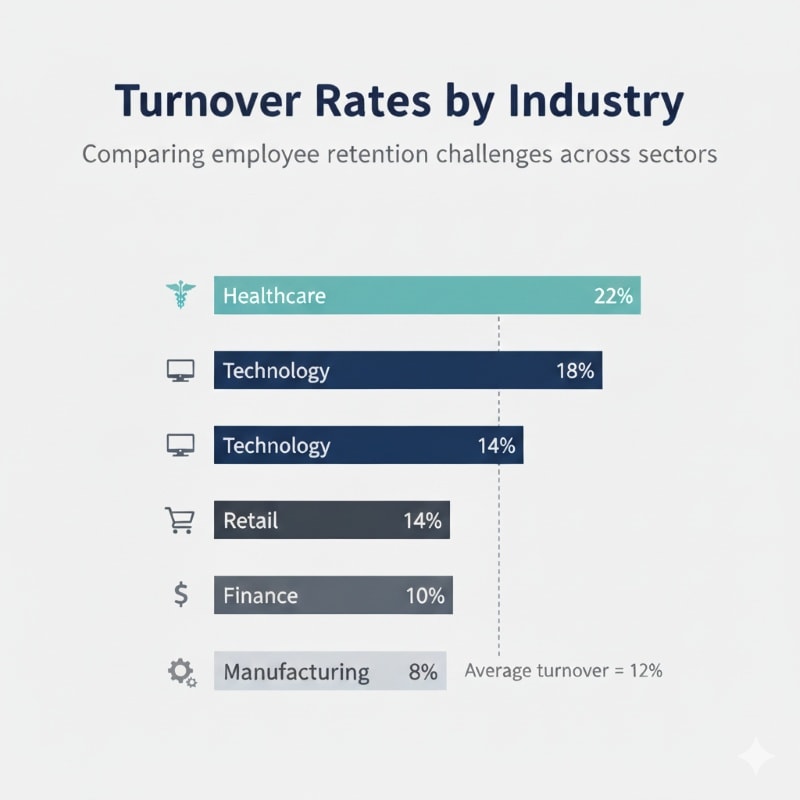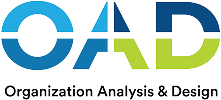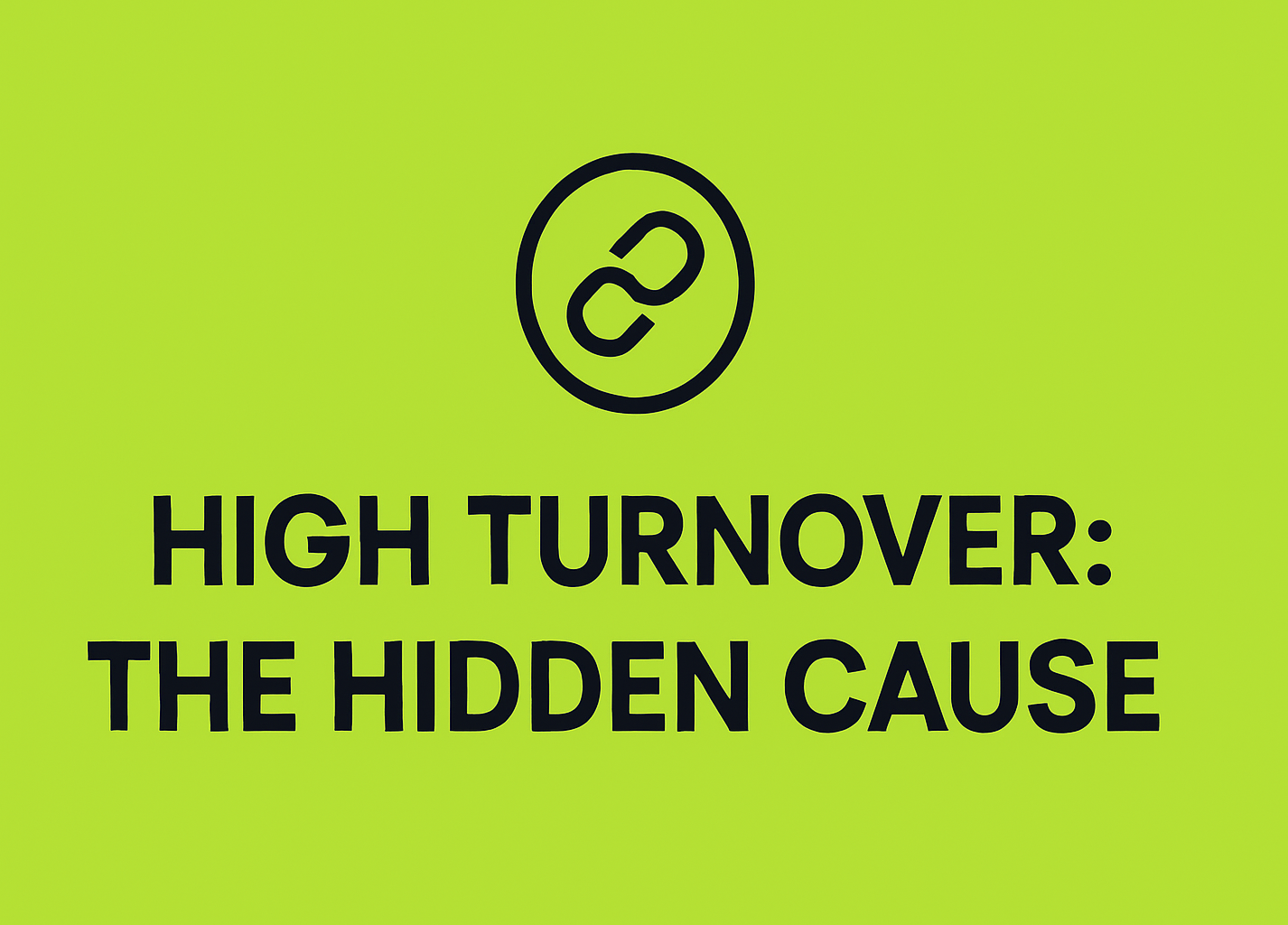Every company faces some degree of employee turnover—but when it becomes a constant, it’s not just a statistic, it’s a signal. You see it when desks stay empty longer, when exit interviews start to sound the same, when managers joke about onboarding being their full-time job. High turnover erodes trust, drains productivity, and quietly eats away at culture long before the finance team notices the cost. Understanding why people leave—and how to stop the cycle—has become one of the most critical challenges for modern organizations.
Table of Contents
- Company High Turnover: The Hidden Causes Most Companies Miss
- Culture Problems: The Silent Killer of Retention
- Compensation Gaps and the Illusion of Loyalty
- The Ripple Effect: How High Turnover Damages Performance and Morale
- When the Hiring Process Fuels the Problem
- The Engagement Equation: Keeping Employees Invested
- Growth and Development: The Real Retention Currency
- Turning Culture into a Retention Engine
- Smart Strategies to Reduce Turnover for Good
- Using Data to Predict and Prevent Turnover
- Industry Differences: Why One-Size Retention Fails
- Preparing for the Future: What Retention Will Look Like in 2030
- Key Takeaways: Building a Company That People Don’t Want to Leave
Company High Turnover: The Hidden Causes Most Companies Miss
High turnover doesn’t erupt overnight—it leaks out slowly. One skipped one-on-one here, one ignored burnout sign there. By the time leadership notices, the exodus is already in motion. At OAD, we often see this pattern months before leadership notices it—small mismatches between role expectations and behavioral tendencies that quietly snowball into disengagement. Negative employee experiences, such as feeling undervalued or unsupported, are a root cause of turnover. From poor management practices to outdated compensation structures, these cracks in the foundation gradually push employees toward the door. Understanding how high employee turnover is a key metric organizations must address is essential for maintaining productivity, morale, and a positive company reputation.
The Obvious Factors: Pay, Stress, and Work-Life Balance
Low pay and long hours get the blame—but research shows it’s often the perceived unfairness of those conditions, not the conditions themselves, that drives resignations. Behavioral economics calls it ‘inequity aversion’—we’ll endure stress if we believe it’s fair.
When employees feel undervalued or chronically burned out, no “pizza Friday” will save morale. Employee satisfaction is closely tied to fair compensation and a healthy work life balance. As Jeff Bezos once noted, ‘Focus on the things that don’t change.’ People will always value fairness and recognition more than freebies.
Compensation, workload fairness, and other benefits remain the baseline currency of retention.
The Invisible Factors: Culture and Connection
What’s more dangerous are the silent causes—like lack of recognition, weak communication, or the feeling that leadership doesn’t listen. A positive employee experience is essential for retention and engagement, as it shapes how valued and connected employees feel within the organization. Employees may not quit for better pay; they often quit because they no longer feel seen. Culture failure is contagious. One disengaged manager can quietly ‘infect’ a dozen others until disengagement becomes the company’s default operating mode.
The Systemic Factor: Misalignment Between People and Roles
Even with great pay and perks, employees disengage when their natural strengths don’t align with their job demands. Accurate job descriptions are essential for ensuring alignment between people and roles, as they clarify expectations and responsibilities. Misalignment leads to frustration, low performance, and early exits. This is where behavioral and personality data, like that provided by OAD assessments, becomes a retention advantage—helping leaders match people to roles where they can truly thrive.
Gallup’s research links strength alignment to a 15% higher engagement rate—but OAD’s data shows why: when behavior and role fit align, psychological strain drops dramatically.
Culture Problems: The Silent Killer of Retention
A company can offer generous pay and benefits, yet still struggle to keep people. Why? Because employees don’t just work for a paycheck—they work for meaning, belonging, and respect. Poor company culture is the slow poison of retention, often invisible until exit interviews start piling up. Over time, high turnover and a negative culture can seriously damage the company’s reputation, making it harder to attract and retain top talent.
We’ve seen this across hundreds of organizations—leaders assume retention is about perks, when it’s really about the emotional contract between company and employee.
When ‘Toxic’ Becomes the Norm
A poor company culture isn’t built overnight—it’s tolerated into existence. Gossip, unclear expectations, favoritism, and unresponsive leadership erode trust one interaction at a time, often resulting in employees leaving due to the toxic work environment. Eventually, the best employees—the ones with options—leave first. The rest quietly disengage.
It starts when a rude manager goes unchecked or when favoritism gets brushed off ‘just this once.’ Before long, that behavior becomes the culture.
Recognition, Safety, and Belonging Matter
Employee engagement isn’t just about perks; it’s about psychological safety. Recognition and psychological safety are key drivers of workplace satisfaction, helping employees feel valued and secure in their roles. When team members feel safe to speak up, make mistakes, and receive recognition for good work, they’re far less likely to look elsewhere. Simple gestures of acknowledgment can outperform even the most polished retention programs.
Google’s Project Aristotle found psychological safety to be the #1 predictor of high-performing teams—OAD’s behavioral data explains why: when people feel safe, they operate from strength instead of fear.
The HR Department’s Role in Culture Repair
High employee turnover puts significant strain on the HR department, increasing its workload and challenges as it manages constant recruitment, onboarding, and reputation concerns. HR professionals can’t fix culture with another survey. They need to partner with leadership to model the right behaviors, define shared values, and hold managers accountable. Sustained improvement begins when culture becomes a measurable business goal—not a feel-good initiative.
At OAD, we often remind leaders that data without action is theater. Culture changes when insight turns into accountability.

Compensation Gaps and the Illusion of Loyalty
Many leaders assume loyalty can be bought with culture alone—but when compensation lags behind market value, even the most committed employees start updating their résumés. Fair pay isn’t just a financial decision; it’s a reflection of how much a company values its people. Offering better compensation, including market-rate pay, regular raises, and comprehensive benefits, can help retain employees and boost overall satisfaction.
When Pay Doesn’t Match Performance
Underpaying high performers is one of the fastest ways to fuel voluntary turnover. People talk, salary benchmarks are public, and resentment grows quickly once employees realize they’re earning less than peers elsewhere. The result isn’t just lost talent—it’s a drop in morale among those who stay, and it can also make your job offer less attractive to top candidates who are comparing compensation packages.
All it takes is one LinkedIn message offering 20% more to remind a star employee how underappreciated they feel.
The Cost of Poor Compensation Strategy
Replacing a single employee can cost between 50% and 200% of their annual salary, leading to increased cost from high turnover due to higher recruitment expenses, agency fees, and the use of internal resources for hiring. Yet many companies still treat raises as an expense, not an investment. Competitive compensation—aligned with skill level, performance, and market data—signals respect and stability, two key drivers of retention.
More Than Money: The Role of Benefits and Recognition
Employees rarely leave solely for a higher paycheck. They leave for better total value: comprehensive benefits packages, health coverage, flexibility, recognition, and trust. A robust benefits package combined with consistent acknowledgment builds emotional equity that money alone can’t replace.

The Ripple Effect: How High Turnover Damages Performance and Morale
High turnover doesn’t just empty desks—it drains energy, weakens trust, and forces surviving employees into constant recovery mode. The real cost isn’t the exit interview; it’s the slow erosion of momentum that follows, often resulting in lost business due to staff shortages and reduced morale.
Productivity Takes the First Hit
Every departure creates a disruption, often resulting in reduced productivity due to turnover and overwork. Projects stall, new hires need time to ramp up, and institutional knowledge disappears faster than it can be replaced. Teams spend more time onboarding and less time innovating, leading to what feels like permanent “catch-up mode.”
As Peter Drucker put it, ‘Culture eats strategy for breakfast.’ No strategy survives the churn of constant departures.
Morale Collapses Under Constant Change
When colleagues keep leaving, even engaged employees begin to wonder if they should, too, and overall employee morale declines as turnover increases. Remaining team members—often referred to as remaining employees—face heavier workloads, increased stress, blurred boundaries, and declining trust in leadership’s stability. What starts as turnover can quickly evolve into widespread disengagement.
The Hidden Financial Drain
The financial impact of turnover extends beyond recruitment costs and includes significant opportunity costs. There’s lost productivity, lower client satisfaction, and damage to a company’s reputation. Over time, high turnover becomes a tax on every department—one that compounds quietly until it shows up in quarterly results.

When the Hiring Process Fuels the Problem
A high turnover rate often starts long before an employee’s first day—it begins in the hiring process, where attracting qualified candidates is crucial. When companies rush recruitment or rely solely on intuition, they increase the risk of poor fit, fast burnout, and early exits.
The Cost of a Bad Hire
A misaligned hire can cost up to three times their annual salary when factoring in training, lost productivity, and replacement expenses, especially when considering the challenges and costs associated with onboarding a new hire. But the real damage lies in the ripple effect: team morale dips, projects stall, and managers lose confidence in the process itself.
Beyond Skills: Hiring for Fit and Potential
Many HR departments still prioritize technical skills over behavioral alignment. But a candidate who can do the job isn’t always one who wants to. Assessing personality traits, motivation, and cultural compatibility reduces early turnover and builds a more cohesive workforce. Additionally, effectively onboarding new workers is crucial to ensure long-term retention and successful integration into the company culture.
Where Science Strengthens the Process
Data-backed tools like OAD assessments help organizations identify not just what candidates can do, but how they’re likely to behave once hired. By mapping behavioral tendencies to role requirements, companies can dramatically cut early attrition and build teams that last.

The Engagement Equation: Keeping Employees Invested
Engagement isn’t a buzzword—it’s the heartbeat of retention. Disengaged employees don’t just underperform; they quietly spread discontent until even the most motivated team members lose their spark. True engagement begins when people feel valued, heard, and connected to the company’s mission, ultimately resulting in a more productive workforce.
Engagement as a Retention Strategy, Not a Perk
Many organizations mistake engagement for entertainment—team lunches, trivia nights, or yet another “fun Friday.” Real engagement runs deeper. It’s about clarity in expectations, fair recognition, and leaders who actually listen. When employees see their contributions matter, they stay.
The Feedback Loop That Builds Commitment
Regular feedback isn’t micromanagement—it’s alignment. Transparent communication between managers and team members builds trust and prevents small frustrations from festering into resignation letters. Frequent, two-way check-ins create connection and accountability in equal measure.
Recognition Programs That Actually Work
A bonus loses impact if it feels transactional. Recognition only works when it’s specific, timely, and authentic. Highlighting an employee’s unique strengths or acknowledging quiet contributions can strengthen loyalty more than any one-time incentive ever could.

Growth and Development: The Real Retention Currency
Employees don’t leave companies—they outgrow them. The moment curiosity stops being rewarded, ambition finds a new home. Growth opportunities and development opportunities are essential for retention. When people can’t see a future for themselves inside an organization, they’ll find one elsewhere. Growth and development aren’t luxuries anymore; career advancement and professional development opportunities are the foundation of long-term retention.
The Ambition Dilemma
Ambitious employees crave challenge. If promotions are rare, training is outdated, or feedback is vague, frustration builds fast. Companies that fail to create upward or lateral mobility lose their most driven people first—the ones competitors are eager to hire.
Development as a Retention Strategy
Offering mentorship programs, skill-building workshops, and clear promotion pathways communicates one thing: “We’re invested in you.” Employees who feel their growth is supported are far less likely to scan job boards. Professional development fosters loyalty by aligning company goals with personal ambition.
Building a Learning Culture That Lasts
A culture of continuous learning requires more than a few online courses. It’s a mindset embedded into daily operations—leaders modeling curiosity, teams encouraged to experiment, and mistakes treated as lessons, not failures. That’s how development becomes part of the company’s DNA.

Turning Culture into a Retention Engine
When culture is strong, retention stops being an HR initiative—it becomes a natural outcome. The best workplaces don’t trap employees; they attract them over and over again because the environment supports growth, connection, and trust.
The Power of Alignment
A healthy culture is built on alignment between what a company says it values and what employees actually experience. If leadership talks about balance but rewards burnout, the message is clear—and turnover follows. Consistency between values, behavior, and recognition builds credibility that keeps people grounded.
Leadership as the Culture Multiplier
Leaders shape culture more than policies ever will. How they handle mistakes, celebrate wins, or address conflict sets the tone for everyone else. Managers who show empathy and fairness create loyalty that money can’t buy. Poor leaders, on the other hand, can undo years of HR effort in weeks.
HR’s Role in Sustaining Culture
HR departments can transform culture from a slogan into a system—through training, data-driven measurement, and accountability. When culture is measured as rigorously as revenue, it evolves from something “nice to have” into a competitive advantage that directly impacts retention.

Smart Strategies to Reduce Turnover for Good
Reducing turnover isn’t about quick fixes or trendy HR programs—it’s about implementing key strategies that address the root causes with deliberate, data-backed action. Companies that approach retention strategically don’t just keep people longer; they build a workforce that’s more engaged, productive, and profitable by taking proactive steps to retain talent.
Start with Honest Diagnostics
You can’t fix what you don’t understand. Conduct exit interviews, engagement surveys, and culture assessments that dig deeper than surface-level satisfaction. The goal isn’t just to collect feedback—it’s to identify patterns that point to systemic issues. Tools like OAD can reveal whether your turnover stems from misaligned roles, leadership gaps, or motivational mismatches.
Design Retention Systems, Not Band-Aids
Retention improves when systems support it. Regular performance check-ins, recognition frameworks, and structured development plans help employees see a future within the company. When these processes are consistent, turnover naturally decreases because employees trust the organization’s long game.
Make Managers the First Line of Retention
The manager-employee relationship is where engagement lives or dies. Invest in leadership training so managers can communicate clearly, coach effectively, and spot disengagement early. A single great manager can retain more talent than any HR campaign.

Using Data to Predict and Prevent Turnover
Gut feeling doesn’t cut it anymore. The most successful companies use data to monitor key metrics like employee turnover rate and detect early signs of disengagement before resignation letters hit the inbox.
To calculate turnover, organizations typically use the average number of employees during a given period—usually by averaging the headcount at the start and end of the period.
Predictive analytics transforms retention from reactive firefighting into proactive strategy, especially when benchmarking your results against the average turnover rate in your industry.
Tracking the Right Metrics
Not all data is useful. Instead of drowning in spreadsheets, focus on metrics that reveal behavior patterns—tenure length, performance consistency, absenteeism, and engagement survey results. When analyzed together, these signals can flag at-risk employees months before they decide to leave.
From Insight to Intervention
Data is only valuable when it drives action. HR departments should translate insights into targeted responses: leadership coaching where turnover spikes, recognition programs for undervalued teams, or workload adjustments in burnout-heavy departments. The goal isn’t just to track numbers—it’s to change outcomes.
Behavioral Data as a Competitive Edge
Psychometric tools like OAD bring precision to retention. By identifying how an employee naturally thinks, communicates, and works under pressure, leaders can tailor management approaches that boost satisfaction and performance. Data-driven understanding turns retention from guesswork into science.

Industry Differences: Why One-Size Retention Fails
No two industries face the same turnover challenges, and some sectors are particularly affected by high turnover rates. What keeps a software engineer loyal won’t necessarily work for a retail associate or healthcare professional.
The average employee turnover rate varies significantly across sectors such as hospitality, retail, manufacturing, and construction, reflecting different job market dynamics and retention challenges.
Understanding the unique pressures of each sector is what separates generic HR strategies from truly effective retention plans, especially since some industries experience higher turnover than others.
High-Competition Industries Face Constant Poaching
In fields like tech or finance, where specialized skills are scarce, high turnover often reflects opportunity—not dissatisfaction. Competitors lure talent with aggressive offers, flexible work, or equity incentives. Companies that can’t compete financially must double down on culture, autonomy, and purpose.
Frontline and Service Roles Struggle with Burnout
Industries dependent on hourly or customer-facing employees face turnover driven by exhaustion and low pay. Here, retention depends less on career ladders and more on better scheduling, recognition, and safety. Stability and respect matter more than perks.
Tailoring Retention Strategies to the Workforce
Each industry demands its own playbook. Manufacturing may focus on skill development and safety, while healthcare invests in emotional support and workload balance. HR professionals who tailor retention to the lived reality of their workforce see far stronger long-term results.

Preparing for the Future: What Retention Will Look Like in 2030
The future of retention isn’t about free snacks or hybrid work experiments—it’s about understanding what truly motivates the next generation of talent. By 2030, companies that thrive will be the ones using data, empathy, and flexibility in equal measure.
AI and Predictive Analytics Will Redefine HR
Artificial intelligence is already transforming how organizations track engagement, forecast attrition, and personalize employee experiences. Instead of waiting for exit interviews, HR teams will use real-time data to identify burnout risks, motivation dips, and career stagnation—then intervene before employees start looking elsewhere.
Flexibility Becomes Non-Negotiable
The pandemic shifted work-life expectations permanently. By 2030, flexibility in schedule, location, and workload will be as standard as healthcare benefits. Companies that cling to rigid structures will find themselves bleeding talent to more adaptive competitors.
Retention Becomes a Shared Responsibility
Future retention strategies won’t belong solely to HR. Every leader, manager, and team member will be accountable for maintaining engagement and alignment. The healthiest organizations will treat retention as an ecosystem—sustained by transparency, trust, and constant feedback.

Key Takeaways: Building a Company That People Don’t Want to Leave
High turnover is rarely about one bad policy or one weak manager—it’s a reflection of how well a company understands and supports its people. The organizations that keep top talent aren’t the ones that try to prevent turnover; they’re the ones that make staying the obvious choice.
Retention Starts with Awareness
You can’t improve what you refuse to measure. Tracking turnover trends, engagement levels, and cultural alignment reveals where problems truly begin. The more data-driven and honest the diagnosis, the faster the recovery.
Culture, Compensation, and Growth Must Work Together
No single initiative can solve turnover. Fair pay keeps employees content, culture keeps them inspired, and growth keeps them invested. When these three align, loyalty stops being accidental—it becomes inevitable.
Build for the Future, Not the Fix
Retention isn’t a one-time campaign—it’s a leadership philosophy. The best organizations treat every hire as a long-term partnership, every promotion as an investment, and every exit as a lesson. The companies that get this right don’t just reduce turnover—they redefine what it means to belong.
Test OAD for free and see how data-driven behavioral insights can help your organization retain top talent, strengthen culture, and reduce costly turnover before it starts.

